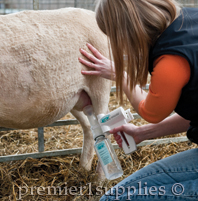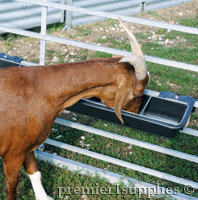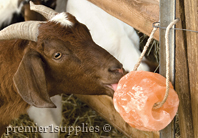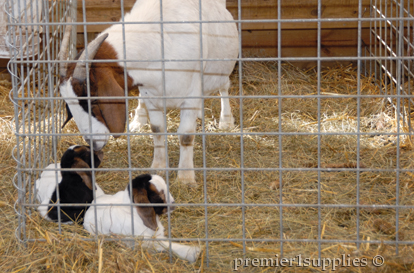MILKING MADE EZ

Using an Udderly EZ Milker on one of our ewes during lambing system. Works equally well on does. Very useful for milking small-teated does.
Udderly EZ™ Milker
Makes obtaining colostrum from a difficult doe or ewe less of an "athletic event".
A few pumps creates a seal allowing the teat valve to open and release milk. The flow is not rapid, but effective.
FOR ORNERY DOES
 GoatTuff Feeder
GoatTuff Feeder
Designed specifically with goat behavior in mind.
| 1. |
Strong, tough, durable. |
| 2. |
Keeps young kids from climbing into the feeder.
|
| 3. |
Prevents boss goats from dominating while feeding. |
| 4. |
Goats can't push feed out sides or ends with their noses. |
GOAT TREATS

One of our Boer nannies enjoying salt on a rope.
Salt on a Rope
Provides an essential nutrient to livestock. Ability to hang prevents the salt from contacting the ground and allows it to dry faster after getting wet from rain or livestock.
|
 |
 |

When kidding, we use the same jugging system as we do for lambing. It's proven to be effective with both species.
Proper nutrition leads
to healthy goats
Depending on your management system, you're either getting ready for kidding now, just completed it or are working on keeping your does healthy through gestation. This is where nutrition comes into play. The doe needs the optimal nutrition for her condition so her kids have a good start at life, which leads to profit for you down the road.
For advice on goat nutrition, you'll find two excellent sources below from Steve Hart and Susan Schoenian. Happy Kidding!
WHAT GOATS NEED...
Introduction to goat nutrition
By Steve Hart, Langston University, Oklahoma
Unit Objective
After completion of this module of instruction, the producer should be able to state the nutritional needs of the goat and to adjust the nutritional needs at specified times during the goat’s production cycle. The producer should be able to recognize nutritional deficiencies or toxicity within the goat herd and make management decisions for correcting such deficiencies and to be able to use the Langston Interactive Nutrient Calculator for specific goat rations. The producer should be able to complete all assignments with 100% accuracy and score a minimum of 85% on the module test.
Specific Objectives
After completion of this instructional module the producer should be able to:
| 1. |
Match terms associated with nutrition to the correct definition. |
| 2. |
Match the parts of the goat’s stomach to the digestive function.
|
| 3. |
State the function of bacteria contained within the goats stomach.
|
| 4. |
Identify the six classes of nutrients. |
| 5. |
State the function of each of the six classes of nutrients.
|
| 6. |
State some causes when there is a deficiency of energy in the goat’s diet.
|
| 7. |
State how fiber is characterized in the goat’s diet. |
| 8. |
Distinguish between fat and water soluble vitamins.
|
| 9. |
Match the different vitamins to the function that each provide related to goat nutrition.
|
| 10. |
Distinguish between macrominerals and microminerals. |
| 11. |
Match each mineral to the function that each provides with goat nutrition.
|
| 12. |
State the major source of minerals that goats consume.
|
| 13. |
State the most important criteria when choosing a mineral supplement. |
| 14. |
State the purpose of integrating salt within a mineral mix.
|
| 15. |
State the approximate yearly cost of minerals for each 150 pound goat.
|
| 16. |
State the acceptable procedure for identification of mineral deficiencies or toxicities. |
| 17. |
State some nutritional requirements for the kidding season.
|
| 18. |
State the meaning of body condition scoring.
|
| 19. |
Match the optimum body condition score during specific periods of the production cycle. |
| 20. |
State the meaning of applied nutrition.
|
| 21. |
State feeding requirements for different classes of goats.
|
| 22. |
State the considerations for and purpose of creep feeding goat kids. |
| 23. |
State the function and need for feeding colostrum.
|
| 24. |
Identify some considerations for ration formulation.
|
| 25. |
State requirements for feeding systems.
|
| 26. |
Match diseases that are associated with nutritional disorders with symptoms.
|
| 27. |
Use the Langston University Interactive Nutrient Calculator for specific goat rations.
|
Read More »
LATE GESTATION NUTRITION
Getting ready for lambing
and kidding
By Susan Schoenian, Extension Sheep & Goat Specialist, University of Maryland, Western Maryland Research & Education Center
What's happening during the last 4 to 6 weeks of pregnancy?
Seventy (70) percent of fetal growth occurs during the last 4 to 6 weeks of pregnancy. Most of the female’s mammary (udder) growth is occurring during this period. At the same time, rumen capacity is decreasing. The result is the need for increased nutrition, usually a more nutrient-dense diet.
Extra nutrition is needed to support fetal growth, especially if the female is carrying multiple fetuses. Extra feed is needed to support mammary development and ensure a plentiful milk supply. Proper nutrition will help to prevent the occurrence of pregnancy toxemia (ketosis) and milk fever. It will ensure the birth of strong, healthy offspring of moderate birth weight.
Birth weight is highly correlated to lamb and kid survival, with low and high birth weight offspring usually experiencing the highest mortality.
Nutrition during late gestation
During late gestation, energy is the nutrient most likely to be deficient. The level of nutrients required will depend upon the age and weight of the pregnant female and her expected level of production, i.e. singles, twins, or triplets.
To meet the increased energy needs during this period, it is usually necessary to feed concentrates (grain). In addition, if forage quality is low, it will be necessary to provide a supplemental source of protein and calcium.
Feeding during late gestation
Examples of late gestation feed rations are:
| • |
3.5 to 4 lbs. of medium to good quality hay plus 1.25 to 1.5 lbs. of concentrate. |
| • |
4 to 5 lbs. of medium quality hay or pasture equivalent plus 0.5 to 1 lb. of concentrate. |
| • |
Limit the roughage intake of ewe lambs and doe kids and mature females carrying 3 or more fetuses and feed 1 lb. of grain per fetus. |
It is important not to underfeed or overfeed pregnant females. Inadequate nutrition may result in pregnancy toxemia, small and weak lambs/kids, higher lamb/kid mortality, reduced colostrum quality and quantity, poor milk yield, and reduced wool production (in the offspring) via fewer secondary follicles.
Fat females are more prone to pregnancy toxemia. They experience more dystocia (birthing difficulties). Overfeeding can result in oversized fetuses that the female cannot deliver on her own. It costs extra money to make ewes and does fat.
Read More »
|
|